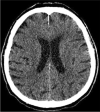Pneumococcal meningitis and COVID-19: dangerous coexistence. A case report
- PMID: 35196995
- PMCID: PMC8864598
- DOI: 10.1186/s12879-022-07156-1
Pneumococcal meningitis and COVID-19: dangerous coexistence. A case report
Abstract
Background: SARS-CoV-2 is the major cause of infections in humans since December 2019 and is top of the global health concern currently. Streptococcus pneumoniae is one of the leading pathogens of invasive bacterial diseases, including pneumonia, sepsis, and meningitis. Moreover, this bacteria is mostly responsible for secondary infections subsequent to post-viral respiratory disease. Co-infections with bacterial and viral pathogens are associated with severe course of the disease and are a major cause of mortality. In this report, we describe a rare case of COVID-19 patient with pneumococcal sepsis and meningitis of unsuccessful course.
Case presentation: A 89-year-old man, not vaccinated against SARS-CoV-2 infection, was diagnosed with COVID-19 pneumonia. Patient required oxygen therapy due to respiratory failure. The initial treatment of viral infection with tocilizumab and dexamethasone allowed for the stabilization of the patient's condition and improvement of laboratory parameters. On the 9th day of hospitalization the patient's condition deteriorated. Consciousness disorders and acute respiratory disorders requiring intubation and mechanical ventilation were observed. Brain computed tomography excluded intracranial bleeding. The Streptococcus pneumoniae sepsis with concomitant pneumoniae and meningitis was diagnosed based on microbiological culture of blood, bronchial wash, and cerebrospinal fluid examination. Despite targeted antibiotic therapy with ceftriaxone and multidisciplinary treatment, symptoms of multiple organ failure increased. On the 13th day of hospitalization, the patient died.
Conclusions: Co-infections with bacterial pathogens appear to be not common among COVID-19 patients, but may cause a sudden deterioration of the general condition. Not only vascular neurological complications, but also meningitis should be always considered in patients with sudden disturbances of consciousness. Anti-inflammatory treatment with the combination of corticosteroids and tocilizumab (or tocilizumab alone) pose a severe risk for secondary lethal bacterial or fungal infections. Thus, treating a high-risk population (i.e. elderly and old patients) with these anti-inflammatory agents, require daily clinical assessment, regular monitoring of C-reactive protein and procalcitonin, as well as standard culture of blood, urine and sputum in order to detect concomitant infections, as rapidly as possible.
Keywords: COVID-19; Co-infection; Meningitis; Sepsis; Streptococcus pneumoniae.
© 2022. The Author(s).
Conflict of interest statement
The authors declare no competing interests.
Figures



References
Publication types
MeSH terms
LinkOut - more resources
Full Text Sources
Medical
Research Materials
Miscellaneous

